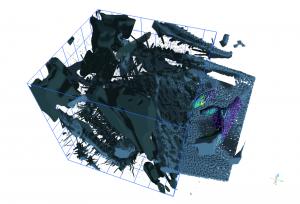ORS Unveils Dragonfly 2020.1 - Putting Deep Learning at the Fingertips of Imaging Scientists Everywhere
Powerful New Dragonfly Release Strengthens Deep Learning Initiative for Improved Scientific Image Analysis
MONTREAL, QUEBEC, CANADA, June 16, 2020 /EINPresswire.com/ -- Object Research Systems (ORS), today announced the release of Dragonfly 2020.1, the latest update to the company’s flagship platform for enterprise scientific imaging. This new release builds upon Dragonfly’s leadership in AI-powered image analysis and delivers a range of new user-friendly wizards, features, and performance enhancements that advance the productivity of imaging scientists. This update brings new tools that are real difference-makers for scientists using electron microscopy and x-ray computed tomography in their research workflows.
Dragonfly is a powerful imaging software solution designed to bring advanced quantitative analysis to scientists, even when they don’t have prior image processing expertise. The software supports a wide variety of modern scientific imaging methods, and its multi-scale, multi-modality, correlative capability integrates disparate imaging experiments. This broad application profile, along with the wide set of advanced image interpretation features makes Dragonfly popular across users in all scientific disciplines. The no-fee licensing model for non-commercial users, unique among commercial scientific imaging frameworks, also drives widespread adoption in the world’s leading university research labs.
The changes introduced with the release of Dragonfly 2020.1 give users more flexibility, better visualization, higher productivity and new application possibilities. These standout features make Dragonfly 2020.1 an impressive improvement on an already highly regarded scientific imaging software.
Dragonfly 2020.1 Highlights
• The Next Generation 3D Rendering Engine impresses with high-definition visualization of scientific and industrial data. This refactored rendering engine delivers enhanced rendering, with smarter hardware optimization, and more accurate lighting and shadowing, producing high-impact visualizations to highlight important details when visually communicating important scientific findings.
• The Segmentation Wizard simplifies and accelerates image segmentation with state-of-the-art AI technologies. Dragonfly’s neural network modeling tools, powered by TensorFlow, are now coupled to more traditional machine learning models. This new wizard streamlines powerful image segmentation workflows for improvement of automated image segmentation of multi-dimensional images. Users paint small areas of interest and the software takes over to train appropriate AI models to accurately label image pixels in a highly efficient iterative process.
• The Bone Analysis Wizard integrates already powerful features for quantitative analysis of bone microstructure into a guided user-friendly workflow. This wizard delivers advanced 3D vector mappings of anisotropy magnitude and directionality and 3D scalar-based mappings of bone volume fraction and other critical quantitative descriptors.
• The MC X-ray Monte Carlo simulation package integrates the toolkit for electron microscopy and energy-dispersive X-ray spectroscopy (EDS) simulation. This popular simulation platform developed by Monte Carlo simulations expert and McGill University Professor of Engineering, Dr. Raynald Gauvin, is now accessible in Dragonfly. This integration unites, for the first time, the advanced physics based simulation solution with a feature-rich image processing and visualization framework.
• The CT Reconstruction module integrates CT reconstruction with quantitative image analysis for research imaging scientists in the fields of materials science, life science, geosciences, and others. The CT reconstruction module integrates TomoPy and RTK for parallel and cone-beam geometries. This integration maximizes what users can do with pre- and post-processing of their CT reconstructions.
See Dragonfly 2020.1 Release Notes for a detailed description of new features and enhancements.
“Dragonfly users have embraced the AI image segmentation tools we introduced almost four years ago, and we knew that making those same tools even more productive with user-guided wizards would eliminate the remaining bottlenecks to scientific image segmentation”, said Mike Marsh, Ph.D, Product Manager for Dragonfly. “Dragonfly 2020.1 is the more capable version yet to solve segmentation problems that slow researchers’ scientific discoveries.”
“We see the results of our team’s hard work and dedication. Our users who had access to the pre-release version of Dragonfly 2020.1 are excited”, commented Normand Mongeau, CEO of ORS. “Everyone was impressed by the new rendering engine and the segmentation wizard allowed them to get results that they had never been able to obtain until now.”
More information about Dragonfly 2020.1 on the ORS website.
About ORS
Object Research Systems develops deep learning powered 3D visualization and image analysis software. Dragonfly, ORS’ flagship product, provides innovators from leading universities or industries, an advanced machine learning and neural networks based segmentation engine. Dragonfly's quantification tools then provide powerful options for counting, measuring, and characterizing image features, such as pores, fibers, grains, and much more. Its user-friendly experience translates its powerful and accurate quantitative findings in high-impact visuals. The ability to build fully automated workflows also enables reproducible results. Curious to learn more? We'd love to show you how Dragonfly can help you!
Nicolas Piché
Object Research Systems
+1 514-843-3861
email us here
Legal Disclaimer:
EIN Presswire provides this news content "as is" without warranty of any kind. We do not accept any responsibility or liability for the accuracy, content, images, videos, licenses, completeness, legality, or reliability of the information contained in this article. If you have any complaints or copyright issues related to this article, kindly contact the author above.

